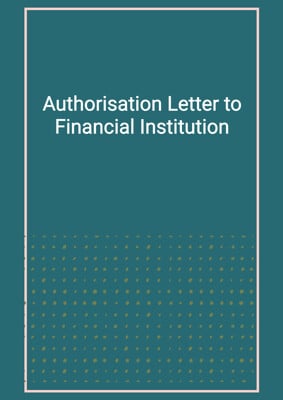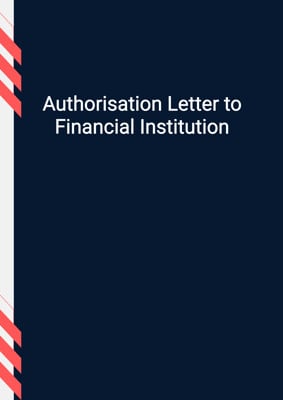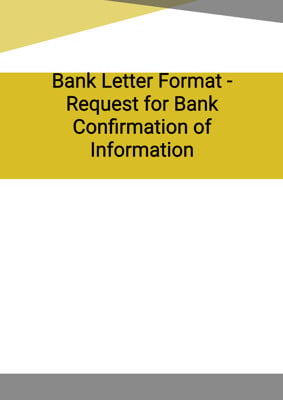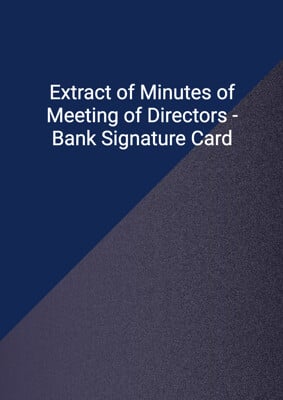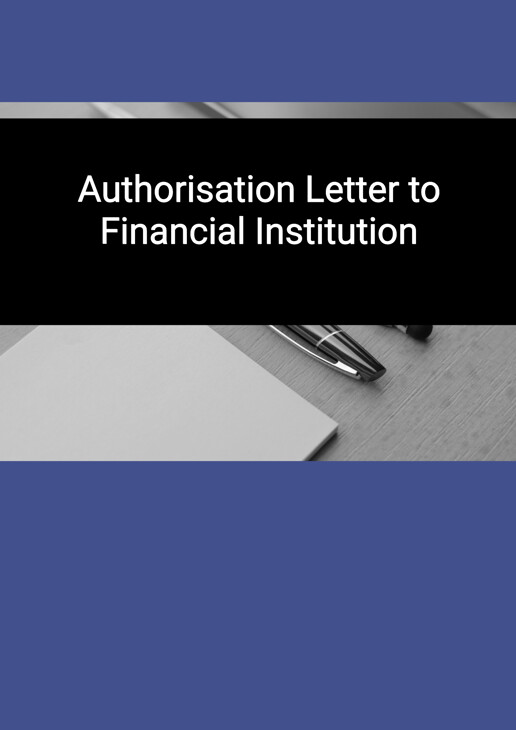
Authorisation Letter to Financial Institution
Third Party to Operate Account
This document is an Authorisation Letter given to a third party in relation to the operation of an account kept with a financial institution for investment / trading purposes. It allows a third party to operate and maintain an account.
How to Tailor the Document for Your Need?
01
Create Document
Fill in the details of the parties. You can click the "Fill with Member’s Information" button to complete it with information saved to your account.
02
Fill Information
Please fill in any additional information by following the step-by-step guide on the left hand side of the preview document and click the "Next" button.
03
Get Document
When you are done, click the "Get Document" button and you can download the document in Word or PDF format.
04
Review Document
The document should be signed by the authorised signatory (or directors of a company) and witnessed to complete the formality.
Document Preview
Document Description
The document titled 'Authorisation Letter to Financial Institution' is a formal letter that grants authorization to a third party to operate a specific account on behalf of the account holder. The importance of this document lies in its ability to legally empower the authorized person to perform various transactions related to the account, such as dealing in securities, signing documents, making purchases or sales, and managing the account's funds.
The entire document consists of a letter addressed to the financial institution, a table of authorized persons, a note section, a risk disclosure statement, and spaces for signatures and witness information.
The letter begins by addressing the account job company and providing the account job address. It is dated with the current date and is addressed to the financial institution. The salutation 'dear sirs / madams' is used to address the institution.
The main purpose of the letter is to authorize a third party to operate the account. The account name and account number(s) are mentioned to clearly identify the account in question. The authorized person is described as someone who is not an employee of the company. The authorization is effective from a specified date.
The table of authorized persons provides space to list the names, identification/passport numbers, addresses, and telephone numbers of the authorized individuals. The table can accommodate up to three authorized persons, and any unused spaces should be crossed out.
A note section is included, instructing the authorized person to complete the account opening form and attach a certified copy of their identification/passport. The note also advises deleting any inappropriate options.
The risk disclosure statement is an important part of the document, emphasizing that appointing an authorized person carries certain risks and legal consequences. The client is advised not to sign the authorization letter without fully understanding its implications and seeking legal advice if necessary.
The document concludes with spaces for the client's name(s), witness name(s), identification/passport numbers, and the date. It also states that the authorization remains in effect until a written notice of revocation is received by the financial institution. The client undertakes to ratify and confirm any instructions given by the authorized person on their behalf.
In summary, the 'Authorisation Letter to Financial Institution' is a comprehensive document that grants authority to a third party to operate a specific account. It includes a letter of authorization, a table of authorized persons, a note section, a risk disclosure statement, and spaces for signatures and witness information.
How to use this document?
1. Complete the letter: Fill in the account job company's name and address, as well as the current date. Address the letter to the financial institution using the salutation 'dear sirs / madams'.
2. Provide account details: Specify the account name and account number(s) to clearly identify the account that the authorization pertains to.
3. Describe the authorized person: List the names, identification/passport numbers, addresses, and telephone numbers of the authorized individuals in the table of authorized persons. Cross out any unused spaces.
4. Follow the note instructions: Ensure that the authorized person completes the account opening form and attaches a certified copy of their identification/passport. Delete any inappropriate options in the note section.
5. Understand the risks: Read and comprehend the risk disclosure statement, which highlights the risks and legal consequences associated with appointing an authorized person. Seek legal advice if necessary.
6. Sign and witness: Sign the document and have it witnessed by another individual. Provide the client's name(s), witness name(s), identification/passport numbers, and the date.
7. Maintain revocation rights: Remember that the authorization remains in effect until a written notice of revocation is received by the financial institution. Ratify and confirm any instructions given by the authorized person on your behalf when requested by the institution.
Note: This guidance provides a brief overview of the steps involved in using the 'Authorisation Letter to Financial Institution' document. It is important to refer to the actual document for precise instructions and details.
Not the right document?
Don’t worry, we have thousands of documents for you to choose from:



